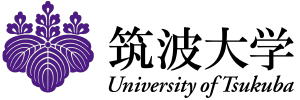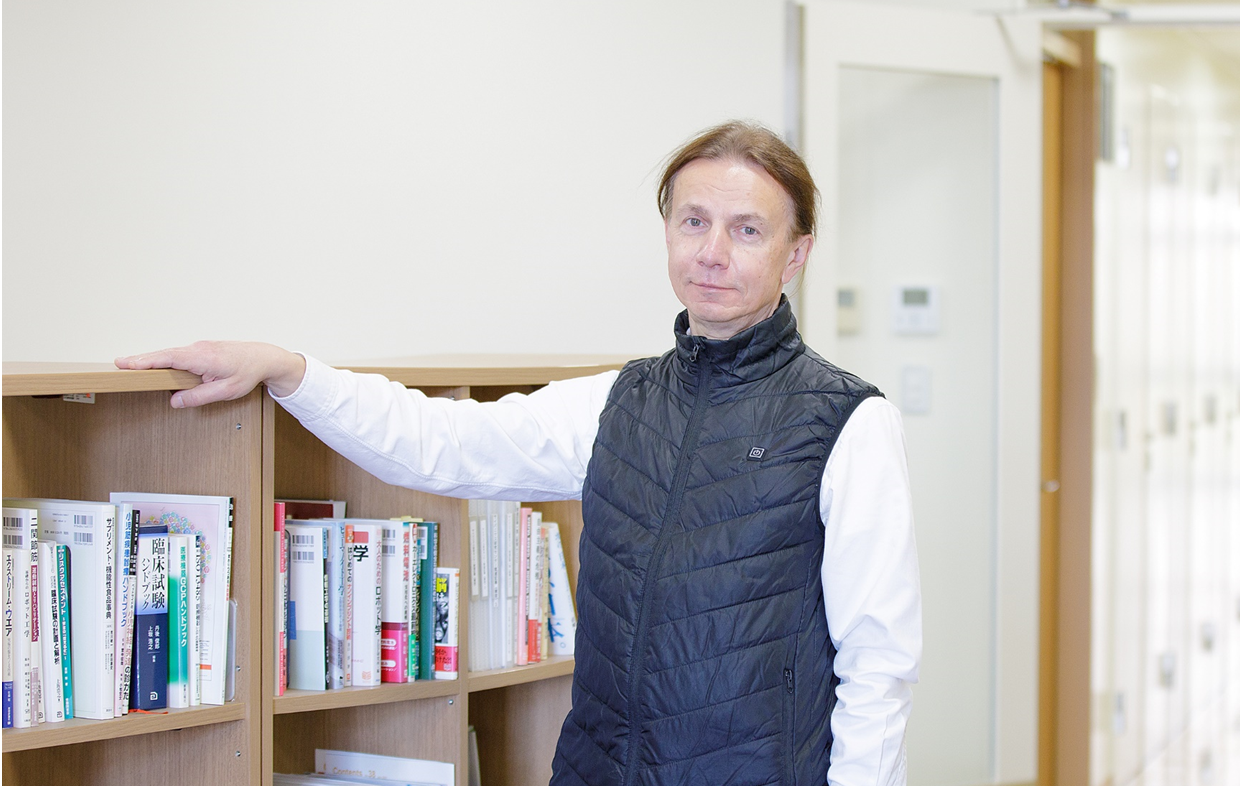社会に有益な細胞提供を考えるきっかけに
A chance to think about cell donation for the benefit of society
Mikhaylov Andrey
サイバニクス研究センター | Center for Cybernics Research
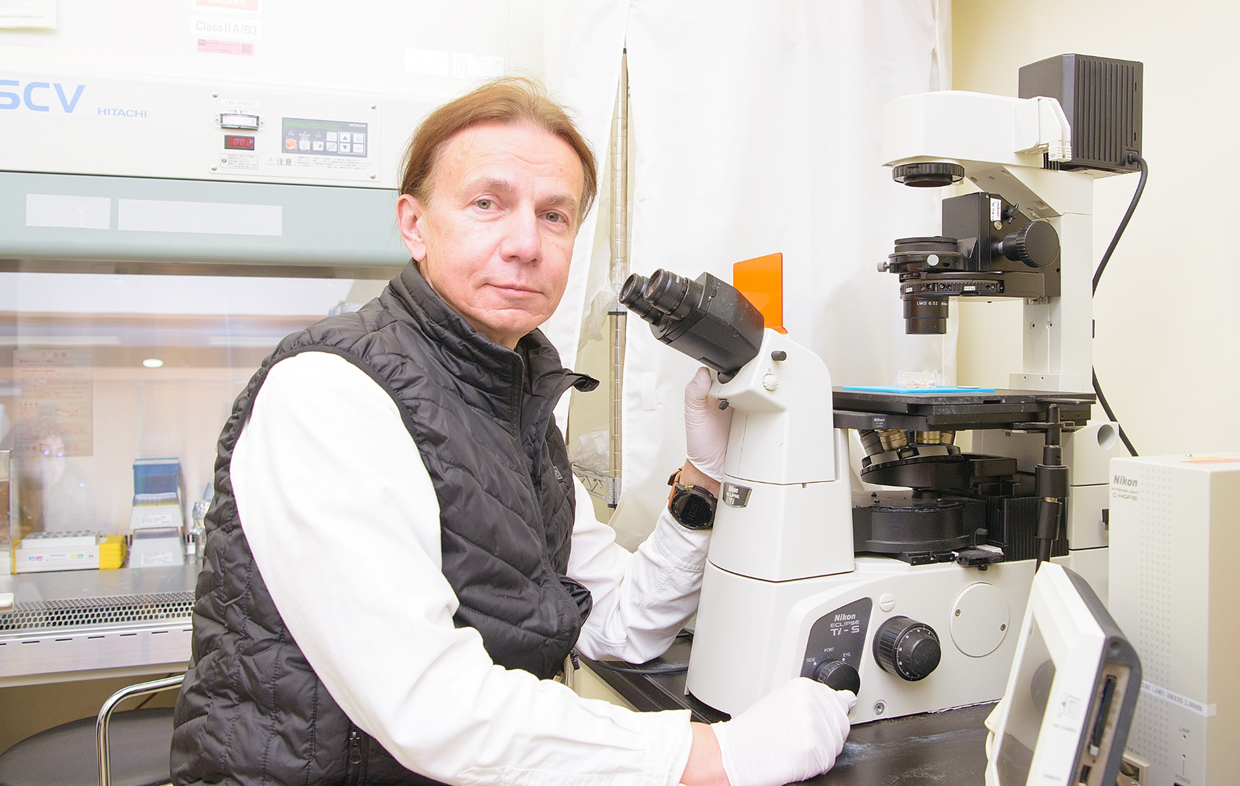
死後幹細胞の医療活用の可能性を探る
現代社会では移植医療が広く受け入れられているとはいえ、「脳死」という概念は、倫理学の一部の学者たちから依然として厳しい批判にさらされています。呼吸や血液循環が数時間停止している「生物学的死」は、倫理的にも社会的にも明確な概念とされる一方で、人の脳は人間の魂と精神の住処であり、また人間の尊厳の起源として最も代表的な器官であると広く受け止められています。
私が研究で取り扱う脊髄にはそのような懸念はありませんが、しかしその脊髄とはいえ、死体からの細胞採取は常に倫理的な議論をもたらすテーマの一つになっています。本プロジェクトでは、そうした死後幹細胞に対する社会的反応と倫理的明確性の評価にも取り組みながら究極的には、個人的に有益な臓器提供から社会的に有益な細胞提供へと、死後提供に関する再認識の議論が始まることを期待しています。
Exploring the Potential Medical Applications of Postmortem Stem Cells
Despite the widespread acceptance of transplantation medicine in modern society, the concept of "brain death" still faces harsh criticism from some scholars of ethics.
While "biological death," in which breathing and blood circulation have ceased for several hours, is considered a distinctly ethical and social concept, it is widely accepted that the human brain is the most representative organ as the home of the human soul and spirit and the origin of human dignity.
The spinal cord, which is the subject of my research, is free of such concerns; however, even the spinal cord, the harvesting of cells from a cadaver has always been one of the subjects of ethical debate.
Ultimately, I hope that this project will initiate a re-conceptualization of postmortem donation from personally beneficial organ donation to socially beneficial cell donation, while also addressing the social response to such postmortem stem cells and assessing ethical clarity.
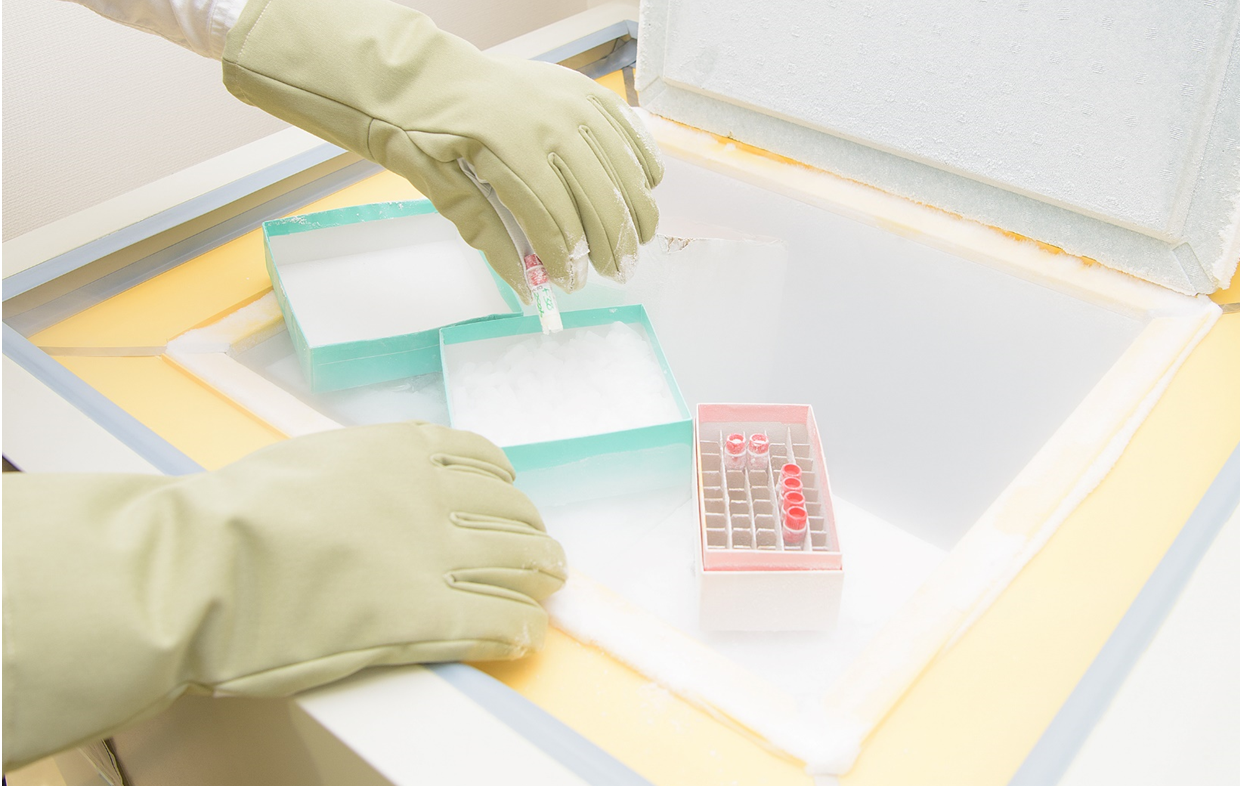
現代の凍結技術ではまだ、組織や臓器ではなく個別の細胞の保存しかできない。
Contemporary freezing technics are only allowing storage of separate cells, not tissues or organs yet.
タンパク質分解酵素を使って細胞の高い生存率を維持
我々の研究では、生物学的に死亡した哺乳類生体から神経幹細胞を採取し、脊髄からの神経幹細胞レポジトリの実現性を探っています。
採取した神経幹細胞は、表面ガングリオシドGD2に対する抗体を用いて磁気分離器で分離します。このアプローチにより、組織の分解にタンパク質分解酵素を使用することができ(GD2抗原は糖脂質であり、タンパク質分解に対して安定しています)、細胞の高い生存率を維持しつつ、ワンステップで十分に濃縮された(細胞)集団に到達することができます。
神経幹細胞が濃縮された細胞集団を培養状態で維持しながら凍結保存し、そこから細胞の収量と純度を推定するために表面抗原プロファイルを検査します。採取した細胞のニューロン、アストロサイト、グリア細胞への分化能と、それぞれの子孫細胞タイプの収量/率を、分化培地を供給した後に試験します。採取した神経幹細胞から分化したニューロンの質は、多電極アレイ上での自発的な電気活動と刺激された電気活動で評価します。
これまで数バッチ分の神経細胞を採取し、その特徴を明らかにし、低温浸漬保存状態で死体脊髄内の生存マージンを推定してきました。
現在は、生存している神経細胞中の神経幹細胞(NSCs)の存在を定量的に評価し、その採取の歩留まりを向上させる段階にあります。
(1)分離されたNSCsの質は、ドナーの年齢や採取時期に依存するのか、(2)死体由来NSCsの複製能や分化能はどの程度なのか、(3)倫理的、文化的、法的な側面から、この技術を医療用途に拡大することは可能か、といった疑問に答えることも計画しています。
Using proteolytic enzymes to maintain high cell viability
Our research explores the feasibility of a neural stem cell repository from the spinal cord by harvesting neural stem cells (NSCs) from biologically deceased mammalian organisms.
The collected neural stem cells are separated in a magnetic separator using an antibody against the surface ganglioside GD2. This approach allows the use of proteolytic enzymes for tissue degradation (the GD2 antigen is a glycolipid and stable against proteolysis) and reaches a well-concentrated (cell) population in one step while maintaining high cell viability.
The method we have been working with first cryopreserves a cell population of enriched neural stem cells, maintained in culture, from which surface antigen profiles are examined to estimate cell yield and purity. Then, the ability of the harvested cells to differentiate into neurons, astrocytes, and glial cells and the yield/rate of each progeny cell type will be tested after supplying differentiation medium. The quality of neurons differentiated from the collected neural stem cells will be assessed by spontaneous and stimulated electrical activity on a multi-electrode array.
We have collected several batches of neurons, characterized them, and estimated the survival margin within the cadaveric spinal cord under cold immersion storage conditions.
We are currently in the process of quantitatively assessing the presence of neural stem cells in surviving neurons and improving the yield of their collection.
We also plan to answer questions such as (1) does the quality of isolated neural stem cells depend on the age of the donor and the timing of collection, (2) what is the replication and differentiation potential of cadaveric neural stem cells, and (3) from ethical, cultural, and legal perspectives, can this technology be expanded for medical applications?
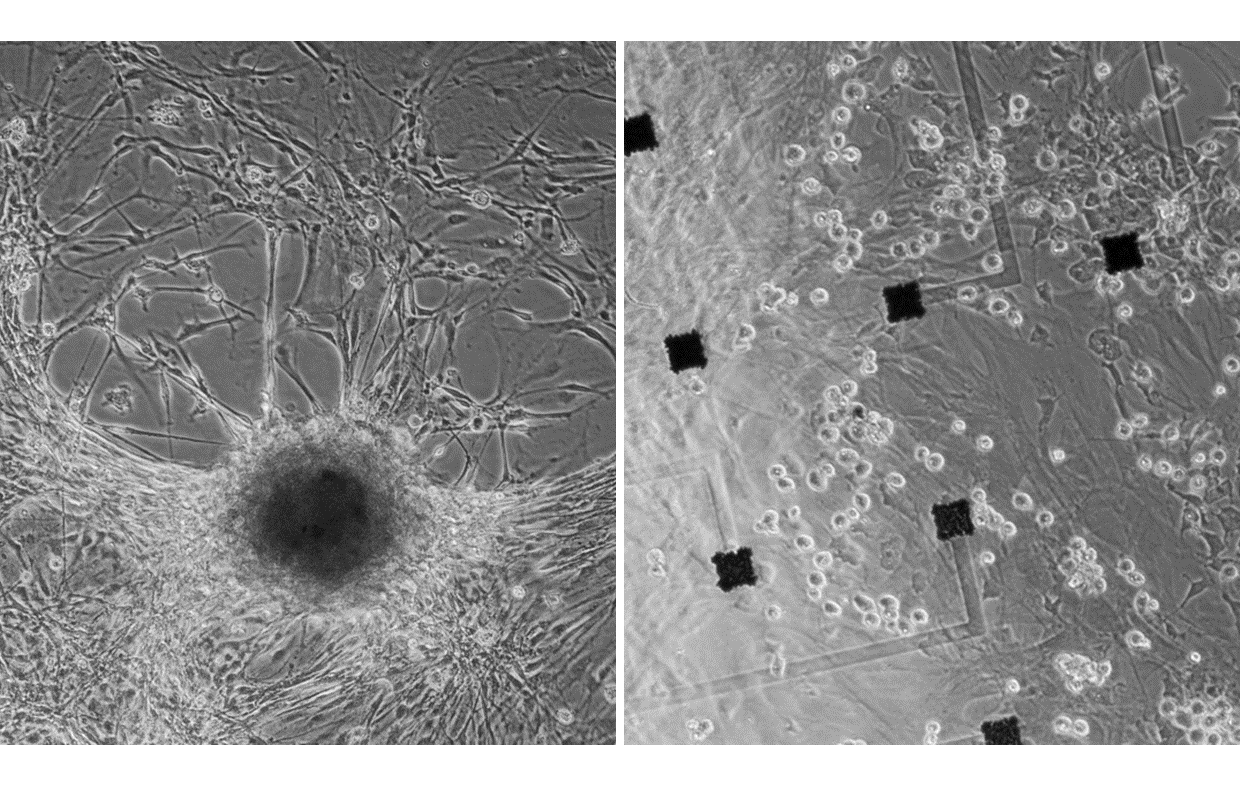
左)死後脊髄から採取され分化したヤギの経幹細胞 右)多電極アレイ上にて、電気的活性を測定するために配置された細胞の分化子孫細胞
(Left) Differentiated caprine neural stem cells collected from postmortem spinal cord. (Right) Differentiated progeny of cells placed to measure electrical activity on a multi-electrode array
医療現場への導入を視野に倫理学チームとのコラボも歓迎
現在直面している課題は、 財政的な制約によるマンパワーの不足や材料を確保・入手する方法の開発が挙げられますが、そこに加えて、死後幹細胞を扱うというチャレンジングかつ多角的なこの研究分野に共同研究者を巻き込めるかどうか。その難しさにも直面しています。
これらの課題を克服するために今はさまざまな資金源に申請し、学際的な科学会議でデータを発表して研究をさらに推進したいと考えています。
人手不足や材料の入手法の開拓の他に、死後幹細胞を扱うというチャレンジングな研究分野であるため対象となる研究資金が限られ、財政難に直面しています。それらを克服するためにさまざまな資金源に申請し、科学会議でデータを発表して研究を推進したいと考えています。
私は神経生理学の専門ですが、他に神経学、社会医学、倫理学、 工学、移植学等の専門家とコンソーシアムを形成し、心理的、社会的、法的観点から医療への応用が可能であるか議論していきたいと考えています。
将来的にこの技術が医療現場に導入される場合、神経組織 提供に対する文化的抵抗は避けられず、これは初期段階である現在から取り組むべき喫緊の課題だと認識しています。そのためにも今後は文化研究や倫理学に貢献するチームとも、学際的な研究を勧めていきたいと期待しています。
また、動物実験に関わる研究者が決して忘れてはならないこととして、医療技術の発展の道のりは動物たちの多大な犠牲の上に成り立っていることを自覚し、常に深い感謝の念を抱いています。趣味の乗馬を通じても動物たちのこと、その性格や求めていることへの理解を深めています。
Collaboration with ethics teams is welcome with a view to introducing this research into the medical field.
The current challenges we face are not only the shortage of manpower due to financial constraints and the development of methods to secure and obtain the materials, but also difficulties due to the limited ability to attract the collaborators for this challenging and multilateral field of research, which deals with postmortem stem cells. To overcome these challenges, I would like to apply for various funding sources and present my data at multidisciplinary scientific meetings to promote my research.
I specialize in cell biology, but I would like to form a consortium with other experts in neurology, social medicine, ethics, engineering, and transplantation, etc., to discuss possible medical applications from psychological, social, and legal perspectives.
If this technology is introduced into medical practice in the future, cultural resistance to neural tissue donation is inevitable, and we recognize that this is an urgent issue that must be addressed now, in the early stages of the project. To this end, I look forward to recommending interdisciplinary research with teams contributing to cultural studies and ethics in the future.
In addition, as a researcher involved in animal experiments, I must never forget that the path to the development of medical technology is based on the great sacrifices made by animals, and I am always deeply grateful for this. Through my hobby of horseback riding, I am also deepening my understanding of animals, their personalities, and their needs.
